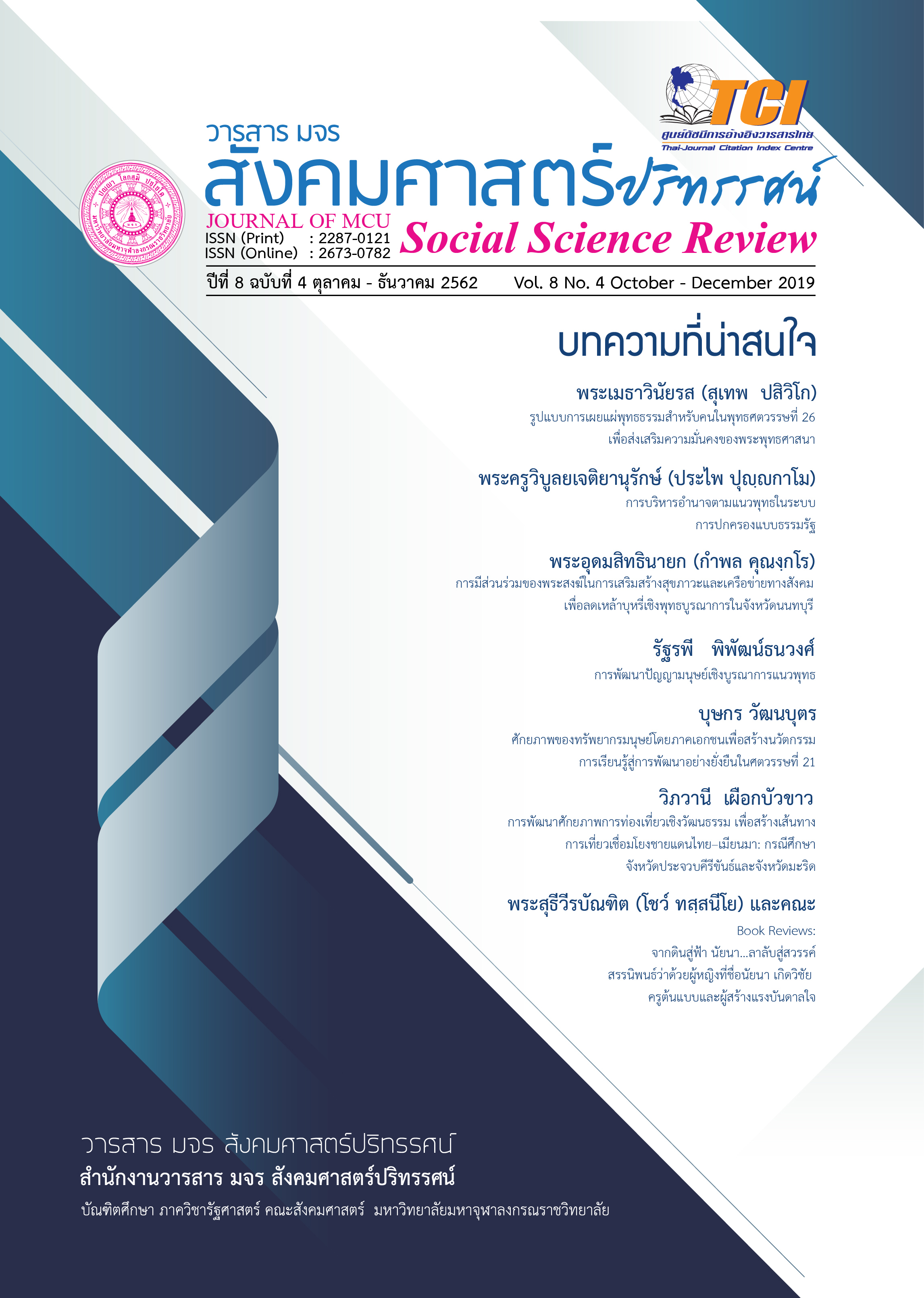การบริหารเครือข่ายสำนักปฏิบัติธรรมในจังหวัดพระนครศรีอยุธยา
คำสำคัญ:
การบริหาร, เครือข่าย, สำนักปฏิบัติธรรมบทคัดย่อ
บทความนี้ มีวัตถุประสงค์ คือ 1) เพื่อศึกษาสภาพทั่วไปของการบริหารจัดการสำนักปฏิบัติธรรมในจังหวัดพระนครศรีอยุธยา 2) เพื่อศึกษาปัจจัยที่ส่งผลต่อการบริหารจัดการสำนักปฏิบัติธรรมในจังหวัดพระนครศรีอยุธยา 3) เพื่อนำเสนอแนวทางการบริหารเครือข่ายสำนักปฏิบัติธรรมในจังหวัดพระนครศรีอยุธยา ระเบียบวิธีวิจัยเป็นแบบผสานวิธีโดยใช้การวิจัยเชิงคุณภาพเป็นหลักและสนับสนุนด้วยการวิจัยเชิงปริมาณตามลำดับ การวิจัยเชิงคุณภาพผู้วิจัยเก็บข้อมูลด้วยการสัมภาษณ์เชิงลึกจากผู้ให้ข้อมูลสำคัญจำนวน 22 รูป/คน โดยแบ่งเป็น 3 กลุ่ม คือ 1) กลุ่มพระสังฆาธิการ 2) กลุ่มเจ้าหน้าที่ภาครัฐ 3) กลุ่มประชาชน โดยวิธีการเลือกแบบเจาะจง (Purposive Selection) และสนทนากลุ่มเฉพาะ (Focus Group Discussion) ผู้ทรงคุณวุฒิจำนวน 11 รูป/คน วิเคราะห์ข้อมูลโดยการวิเคราะห์เนื้อหาเชิงพรรณนา การวิจัยเชิงปริมาณ (Quantitative Research) ผู้วิจัยได้สร้างแบบสอบถามซึ่งมีค่าความเชื่อมั่นทั้งฉบับเท่ากับ 0.983 เพื่อเก็บรวบรวมข้อมูลจากผู้ปฏิบัติธรรมของสำนักปฏิบัติในจังหวัดพระนครศรีอยุธยา จำนวน 397 รูป/คน วิเคราะห์ข้อมูลด้วยสถิติค่าความถี่ (Frequency) ค่าร้อยละ (Percentage) ค่าเฉลี่ย (Mean) ค่าส่วนเบี่ยงเบนมาตรฐาน (Standard Deviation : S.D.)
ผลการวิจัยพบว่า
- สภาพทั่วไปของการบริหารจัดการสำนักปฏิบัติธรรมด้วยการวิเคราะห์ SWOT Analysis ด้านจุดแข็งสถานที่ปฏิบัติธรรมโดยมากมีความเป็นสัปปายะมีการสนับสนุนการอบรมหลักสูตรพระวิปัสสนาจารย์ต่อเนื่องมีพระวิปัสสนาจารย์ใช้หลักธรรมคำสั่งสอนตรงตามหลักพระพุทธศาสนาโดยยึดหลักการเจริญสติปัฏฐาน 4 ด้านจุดอ่อนสำนักปฏิบัติธรรมหลักๆ ที่เป็นต้นแบบยังมีอยู่น้อยหลักการปฏิบัติธรรมยังใช้หลักสอนแบบสืบต่อกันมาจากครูบาอาจารย์ด้วยความเคารพและศรัทธาส่วนใหญ่ นโยบายการบริหารสำนักเป็นไปตามความดำริของเจ้าสำนัก ด้านโอกาสคณะสงฆ์และหน่วยงานภาครัฐให้การสนับสนุนจัดกิจกรรมของสำนักปฏิบัติธรรม มีการเผยแผ่หลักธรรมคำสอนผ่านทางสื่อสารสนเทศ เว็บไซต์ด้านอุปสรรคสำนักปฏิบัติธรรมแต่ละสำนักมีพื้นฐานประสบการณ์และความพร้อมแตกต่างกัน ขาดความเป็นเครือข่ายเดียวกัน ขาดศูนย์กลางประสานงานร่วมกันและการกระจายข้อมูลข่าวสารติดตามผลไปยังเครือข่าย ขาดการขับเคลื่อนการปฏิบัติงานที่เป็นรูปธรรม ความคิดเห็นต่อสภาพการบริหารเครือข่ายสำนักปฏิบัติธรรมตามหลักการบริหารงาน 5 ด้าน โดยภาพรวมอยู่ในระดับมาก (= 4.00) และตามหลักอิทธิบาท 4 โดยภาพรวมอยู่ในระดับมาก (= 4.10)
- ปัจจัยที่ส่งผลต่อการบริหารจัดการสำนักปฏิบัติธรรมในจังหวัดพระนครศรีอยุธยา
การบริหารจัดการสำนักปฏิบัติธรรมใช้หลักบริหาร 4M มีการบริหารคน บริหารเงินหรืองบประมาณ บริหารวัสดุอุปกรณ์ และการจัดการ จะต้องคำนึงถึงสภาพแวดล้อมทั่วไปทั้งภายในและภายนอกว่าแต่ละสำนักมีพื้นฐานประสบการณ์และความพร้อมแตกต่างกัน ดังนั้นต้องมีการประชุมร่วมกันทุกภาคส่วนเพื่อวางแผนการบริหารทำงานให้ชัดเจน ผู้บริหารหรือเจ้าสำนักจะต้องให้ความสำคัญดูแลเอาใจใส่ในการปฏิบัติงานร่วมกันในทุกกระบวนการ - การนำเสนอการพัฒนารูปแบบการบริหารเครือข่ายสำนักปฏิบัติธรรมในจังหวัดพระนครศรีอยุธยา การพัฒนารูปแบบการบริหารเครือข่ายต้องจัดการประชุมพูดคุยปรึกษาหารือร่วมกันของทุกภาคส่วนเพื่อวางแผนร่วมกันการบริหารจัดการงาน 5 ด้าน 1) ด้านการวางแผน
2) ด้านการจัดองค์กร 3) ด้านบุคลากร 4) ด้านอำนวยการ 5) ด้านการกำกับดูแล และเชื่อมโยงต่อไปยังแผนการบริหารปัจจัยที่ส่งผลต่อการบริหาร 4M ร่วมกัน 1) ด้านคน 2) ด้านเงิน
3) ด้านวัสดุ 4) ด้านการจัดการ เชื่อมโยงกับแผนการบริหารหลักพุทธธรรมอิทธิบาท 4 ร่วมกัน
1) ฉันทะ 2) วิริยะ 3) จิตตะ 4) วิมังสาโดยตั้งอยู่บนพื้นฐานมีการรับรู้และมุมมองที่เหมือนกัน มีวิสัยทัศน์ร่วมกัน มีความสนใจหรือผลประโยชน์ร่วนกัน มีส่วนร่วมของสมาชิกในเครือข่าย มีการเสริมสร้างซึ่งกันและกันมีการเกื้อหนุนพึ่งพากัน มีปฏิสัมพันธ์แลกเปลี่ยนกันและเชื่อมโยงต่อไปยังศูนย์กลางข้อมูลประสานงานและติดตามผลเชื่อมโยงไปยังงานประชาสัมพันธ์ เชื่อมโยงต่อไปยังเจ้าสำนักปฏิบัติธรรมในจังหวัด เชื่อมโยงนำไปปฏิบัติในสำนักของตน ถ้าพบปัญหาอุปสรรคเชื่อมโยงกลับมายังศูนย์กลางข้อมูลประสานงาน
เอกสารอ้างอิง
Banchong Soddee and the faculty. (2006). Thestudy of The Development Guidelines for The Dharma Practice Office in The 11Th Sangha Region. (Research Report). Graduate School : Mahachulalongkornrajavidyalaya University.
Division of Buddhist Studies. (2011). National Buddhism Office. Operation Manual: Request for Establishment of Dharma Practice Center. Bangkok : National Buddhism Printing Office.
Division of Buddhist Studies. (2011). National Buddhism Office, Operation Manual: Request for Establishment of Dharma Practice Center. Bangkok : National Buddhism Printing Office.
Mitchell. J.C.S. (1968). Networks in Urban Situation. Manchester : Manchester University.
Phichayapa Yuen. (2009). Human Resource Management Model in Higher Education Institutions (Doctor of Thesis). Graduate School : Silpakorn University.
Phrakhru Phawana Sophit (Boonrat Muangwong). (2010).Buddhism propagation management in Lanna (Doctor of Thesis). Graduate School : Pathumthani University.
Phrakhru Wisuthanantakhun (Surasak Wisutthajaro). (2016). Temple Management for Security of Buddhism (Doctor of Thesis). Graduate School : Mahachula-
longkornrajavidyalaya University.
Robbin. J.C. (1993). Ideology and the New Social Movement. London : Unwin Hyman.
Starkey. Paul. (1997). Networking for Development. London : IFRTD The International Forum for Rural Transport and Development.
Yaowapa Buaivej. (2007). Public Relations Management Model. Rajabhat University. (Doctor of Thesis). Graduate School : Silpakorn University.
ดาวน์โหลด
เผยแพร่แล้ว
รูปแบบการอ้างอิง
ฉบับ
ประเภทบทความ
สัญญาอนุญาต
ลิขสิทธิ์ (c) 2019 วารสาร มจร สังคมศาสตร์ปริทรรศน์

อนุญาตภายใต้เงื่อนไข Creative Commons Attribution-NonCommercial-NoDerivatives 4.0 International License.
เพื่อให้เป็นไปตามกฎหมายลิขสิทธิ์ ผู้นิพนธ์ทุกท่านต้องลงลายมือชื่อในแบบฟอร์มใบมอบลิขสิทธิ์บทความให้แก่วารสารฯ พร้อมกับบทความต้นฉบับที่ได้แก้ไขครั้งสุดท้าย นอกจากนี้ ผู้นิพนธ์ทุกท่านต้องยืนยันว่าบทความต้นฉบับที่ส่งมาตีพิมพ์นั้น ได้ส่งมาตีพิมพ์เฉพาะในวารสาร มจร สังคมศาสตร์ปริทรรศน์ เพียงแห่งเดียวเท่านั้น หากมีการใช้ภาพหรือตารางหรือเนื้อหาอื่นๆ ของผู้นิพนธ์อื่นที่ปรากฏในสิ่งตีพิมพ์อื่นมาแล้ว ผู้นิพนธ์ต้องขออนุญาตเจ้าของลิขสิทธิ์ก่อน พร้อมทั้งแสดงหนังสือที่ได้รับการยินยอมต่อบรรณาธิการ ก่อนที่บทความจะได้รับการตีพิมพ์ หากไม่เป็นไปตามข้อกำหนดเบื้องต้น ทางวารสารจะถอดบทความของท่านออกโดยไม่มีข้อยกเว้นใดๆ ทั้งสิ้น





